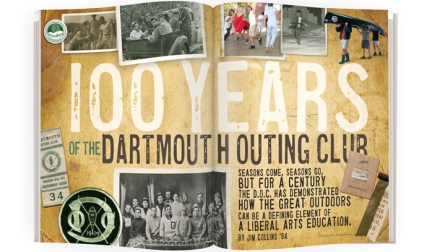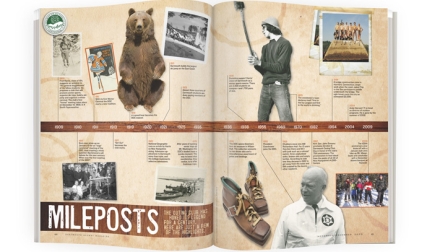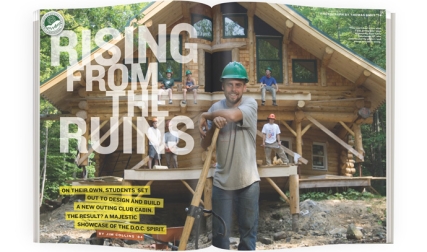In the spring of 1941, near the end of my freshman year, I was invited to join the Moosilauke summit crew. I declined the three-year commitment and instead became one of a two-man crew that repaired Outing Club cabins—a one-summer deal. My mate on the crew was Bert Headley ’42, who got us around in an old Essex, for which he was paid a nickel for each mile driven.
As July Fourth neared we were invited to a party at the Summit Camp. We and three others rendezvoused at the end of the gravel road at the Ravine Camp. The Essex had groaned during the seven-mile uphill pull from Warren. “Drat,” said Bert, looking at the dipstick. “Out of oil again.” He decided to coast back down and get some.
As we turned the Essex around its back wheels dropped into the ditch. Leaving the front wheels cramped downhill, Bert got out to help push. We heaved. She started to roll. Bert jumped onto the running board and grabbed the steering wheel through the open window, then screamed, “I can’t get in!” Bert and the Essex disappeared around a curve. Hard to believe now, but we left Bert to providence, turned away and climbed the mountain, an especially heinous crime for me, his partner.
If Bert was upset by our desertion, he didn’t show it when he got to the Summit Camp—missing considerable skin—two hours later. At the T in the Warren-North Woodstock road Bert had turned the wheels uphill and jumped. The Essex started the turn, then crossed the highway and took a big beech head on. It was the end of the cabin crew for that summer. Bert got a job at a girls’ camp, and I was given another chance and joined the summit crew.
The 1941 crew had two members from the class of 1942: Dave Heald, hut-master, and Harry Bond, sort of co-hut-master. Bob Straub ’43 would be hut-master come 1942. Also there were Al Whitlock ’44, who repaired trails, and naturalist Bob White ’42. Three of us had fathers who were from the class of 1911.
The Summit Camp, an eccentric building, was a charming foil to the limitless space around it. The principal entry opened into the big living room and its fireplace near a generous kitchen and a long dining room. Upstairs were two big bunkrooms and a mix of small chambers, the whole connected by narrow halls and dim stairways.
The crew climbed the mountain via the Snapper, the ski trail that joins the Carriage Road about two miles below the summit. Fresh stuff—bread, eggs, meat—and odds and ends were carried up on packboards. Loads of 50 or 60 pounds, sometimes more, were taken up that way.
Even with a light burden the first 15 minutes hurt. Then came the warm pleasures that well-conditioned lungs and limbs allow—the regular, deep breathing and the satisfying push down against the ground and up against the load. Reaching the top, hot and wet, we were helped from under our boards, then ran down to the spring, stripped and danced over the sedge meadow, yelling as pails of cold water were thrown over us.
The big stuff—cases of No. 10 cans of veggies, sugar, flour and powdered milk—were brought up the just-passable Carriage Road by small but hard and handsome Charlie Andrews and his team of horses and buckboard. He’d driven ammunition wagons in France during World War I and, at 68, had tales to tell.
Most of our guests were kids from summer camps in nearby New Hampshire and Vermont. They generally started in Oliverian Notch on the west side of the mountain and came up the Glencliff Trail. They came in clamoring, sweating, barelegged droves—50 or 60 of them on most weekdays during July and August. They had supper, spent the night, and after breakfast descended to Kinsman Notch on Moosilauke’s east side by the Beaver Brook Trail.
The food we served was ordinary, but a climber’s appetite is strong. Most noticed were the thick pancakes, laid on with butter, syrup and a fast preamble that went: “These pancakes are guaranteed not to rip, run, rust, tear, tarnish, melt, break, bend, freeze, corrode, explode, turn up at the edges, tear at the seams, give off poisonous gases, chip, crack, peel, alligator or grow hair on bald heads or billiard balls.”
We preferred female campers and counselors, not only because they were girls but also because they were such enthusiastic doers of dishes while singing “Clementine,” “Coral Bells” and “How Can I Leave Thee?” After dishes we built up the living room fire and had more songs.
The evening’s climax was the “Moosilauke Ghost Story,” the tale of old Doc Benton. It was accompanied by remote thumps, slammed doors, rattling chains and the sound of feet on stairs. When Benton finally burst in, the hikers screamed with one voice. One night as I played his part, wearing the bedsheet and rubber mask that made the bald old ghost with crabbed face so real, an adolescent hero leaped up and grappled with me.
One morning I started down from the summit wearing my packboard loaded only with letters for mailing. It was a beautiful midsummer day—warm, blue, almost cloudless, moderately hazy, unusually still. Just before the trail plunged into the krummholz, the tight elfin forest of balsam, spruce and birch, I stopped to sate myself with the marvelous prospect off to the east. The mountains just in front were green, but those beyond were blue from the haze, rank after rank, gradually paling, finally disappearing. Shining like mercury was Lake Winnipesaukee, 20 miles away.
I didn’t much feel like descending through the diminishing view and heightening trees to the ordinary world below, but on that day nothing seemed unacceptable. There was not a sound but now and then the song of a black-throated green warbler. It was so quiet I fancied I could hear faint crackling or hissing from dancing gas molecules in the air around me. Suddenly I was swept by a wave of joyousness as had never struck me before—an ecstasy such as that which seizes a zealot during a religious frenzy, perhaps, but I had no unearthly vision, just the sight of those blue mountains. I exulted—filled with the perfection of the world.
Up on the mountain the thunderstorms that roll across northern New England on the hot days gave us spectacles. Thinking ourselves indestructible, we went walking among the flashes and held girl-hikers’ hands. We sometimes hoped for a weekend of weather bad enough to discourage climbers so we could have a day or two of semi-leisure. One Sunday afternoon we were lazing before the fire listening to “Scheherazade” on Harry Bond’s record player. The summit had been socked in for two days and, now, the rip and crash of a thunderstorm was going on all around us. Suddenly there was a report like the discharge of a 12-gauge shotgun inside the house. Close on the bang the hall door sprang open and a fireball came down the two steps into the living room. Smooth, without the flicker and lick of flame, it was the shape and color of a ripe pumpkin about 20 inches in diameter. It floated in gracefully and carefully, as a lady picking up her long skirts might do so as not to trip; then it stopped, hovered for a few seconds a couple of feet above the floor and noiselessly disappeared. In the kitchen the man starting supper had been knocked down and all the pots had fallen from their wall.
Late in summer the cold northwest wind might follow a departing storm and sweep away all haze. Then the blue mountains of earlier were green or black and we could see great distances, even the tower of Baker Library 30 miles away or Mt. Marcy clear across Vermont to New York State’s Adirondacks, 105 miles away. Passing clouds immersed us in super-cooled water vapor and coated things with the feathery ice called rime. We pulled up extra blankets and were reminded that this so-fortunate time was soon to end.
Richard H. Backus is a retired biological oceanographer who lives in Woods Hole, Massachusetts.




